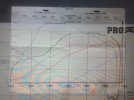Bjorn Nilson
True Classic
Yes I have curves @1bar. I will post them tomorrow.
I imagine there can be lots of little differences that can make the power output change between the two engines, even at the same boost. Think in terms of efficiency; both having the same boost level but maybe one engine can use it better due to greater efficiency. Plus there may be differences in the tune settings, the charge temperature, the exhaust system, etc, etc. Even the dyno (rolling road) test results can vary a lot between two facilities, especially on different days with different weather conditions, etc. Simply too many factors involved to make a side by side comparison.This I do not understand. -Janis bigger engine should perform better than mine at same boost.
Yes I have curves @1bar. I will post them tomorrow.
Yes same, just didn’t crop them into jpegJust a simple look by eye, the "HP" curves are not that much different. The slightly bigger turbo moves the power up a bit in the RPM range. But the "torque" curves - especially in the region around the arrows (below) - are more significant. Maybe this is the difference from the engine sizes? If so then it is more than I thought (at least there). But they are also two completely different turbo designs. So that may make a large change in how they affect the power bands (e.g. the compressor maps).
View attachment 44148
Janis, are both charts the same scale on the left (difference in numbers and spacing on the graph)?

Maybe there aren't too many existing. Definitely none over here. Turbos on factory engines were mostly diesels for a long time. Mainly in more recent years before they started putting them on petrol engines. So I'm guessing those are likely to be more modern engines with 16 valves, etc., and the aftermarket usually supports the most common demand, like upgrades for the UT/Punto GT smaller engines (not 1600cc).I would like to see some other 1.6 8v turbo for comparison, can’t find on google on fast search
Definitely not, on fiatforum.com few years ago found anothers. As I understand it’s one of the choices between Punto GT owners - to change their 1.4 turbo for 1.6NA and add turbo system..You may have one of the only ones that exists?
That makes sense. Because we never saw any of those cars or engines here, a turbo 1.6 SOHC really doesn't exist.Definitely not, on fiatforum.com few years ago found anothers. As I understand it’s one of the choices between Punto GT owners - to change their 1.4 turbo for 1.6NA and add turbo system..
Yes, not from the factoryThat makes sense. Because we never saw any of those cars or engines here, a turbo 1.6 SOHC really doesn't exist.
I agree. That's the reason the factory turbo engines use a small turbo. Good torque, especially at lower RPM's, make for a good driving car on the streets.At my understanding low rpm torque is more likely because that small IHI spools up instantly.
